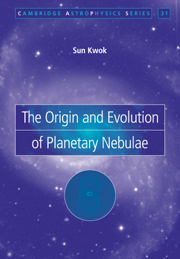Book contents
- Frontmatter
- Contents
- Preface
- 1 History and overview
- 2 Ionization structure of planetary nebulae
- 3 Nebular line radiation
- 4 Nebular continuum radiation
- 5 The neutral gas component
- 6 The dust component
- 7 Observations of the central star of planetary nebulae
- 8 Morphologies of planetary nebulae
- 9 Problems and questions
- 10 Asymptotic giant branch stars – progenitors of planetary nebulae
- 11 Evolution of the central stars
- 12 Formation of planetary nebulae
- 13 Dynamical evolution of planetary nebulae
- 14 Protoplanetary nebulae – the transition objects
- 15 Evolution to the white dwarf stage
- 16 Distances to planetary nebulae
- 17 Comparison between evolutionary models and observations
- 18 PN in the galactic context
- 19 Chemical abundances
- 20 Planetary nebulae in other galaxies
- 21 Concluding remarks
- References
- Appendix List of symbols and abbreviations
- Subject index
14 - Protoplanetary nebulae – the transition objects
Published online by Cambridge University Press: 04 November 2009
- Frontmatter
- Contents
- Preface
- 1 History and overview
- 2 Ionization structure of planetary nebulae
- 3 Nebular line radiation
- 4 Nebular continuum radiation
- 5 The neutral gas component
- 6 The dust component
- 7 Observations of the central star of planetary nebulae
- 8 Morphologies of planetary nebulae
- 9 Problems and questions
- 10 Asymptotic giant branch stars – progenitors of planetary nebulae
- 11 Evolution of the central stars
- 12 Formation of planetary nebulae
- 13 Dynamical evolution of planetary nebulae
- 14 Protoplanetary nebulae – the transition objects
- 15 Evolution to the white dwarf stage
- 16 Distances to planetary nebulae
- 17 Comparison between evolutionary models and observations
- 18 PN in the galactic context
- 19 Chemical abundances
- 20 Planetary nebulae in other galaxies
- 21 Concluding remarks
- References
- Appendix List of symbols and abbreviations
- Subject index
Summary
The evolutionary stage between the end of the AGB and PN phases has long been a missing link in our understanding of single-star evolution. As we discussed in Chapter 10, the AGB is terminated by the depletion of the H envelope by mass loss, and this occurs before the onset of carbon detonation. When mass loss reduces the mass of the H envelope (Me) below a certain value (Me ∼ 10–3M⊙ for a core mass [Mc] of 0.60 M⊙, Schönberner 1983), the star will begin to evolve toward the blue side of the H-R diagram. The effective temperature of the star will increase as the remaining H envelope continues to diminish by H-shell burning. This phase will last until the central star is hot enough (T* ∼ 30,000 K) to ionize the circumstellar nebula. The emergence of recombination lines of H, He, and forbidden lines of metals will make the nebula easily observable in the visible, signaling the beginning of the PN phase. A sketch of the evolutionary tracks of proto-planetary nebulae (PPN) in the H-R diagram is shown in Fig. 14.1.
PPN can be defined as the stage of evolution in which their central stars have stopped the large-scale mass loss on the AGB, but have not evolved to be hot enough to emit a sufficient quantity of Lyman continuum photons to ionize the surrounding remnants of the AGB envelope.
Information
- Type
- Chapter
- Information
- The Origin and Evolution of Planetary Nebulae , pp. 151 - 166Publisher: Cambridge University PressPrint publication year: 2000
